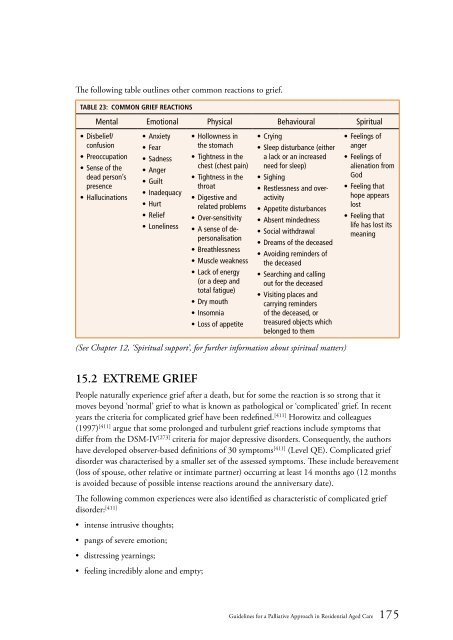Guidelines for a Palliative Approach in Residential Aged Care
Guidelines for a Palliative Approach in Residential Aged Care
Guidelines for a Palliative Approach in Residential Aged Care
Create successful ePaper yourself
Turn your PDF publications into a flip-book with our unique Google optimized e-Paper software.
The follow<strong>in</strong>g table outl<strong>in</strong>es other common reactions to grief.<br />
Table 23: Common grief reactions<br />
Mental Emotional Physical Behavioural Spiritual<br />
• Disbelief/<br />
confusion<br />
• Preoccupation<br />
• Sense of the<br />
dead person’s<br />
presence<br />
• Halluc<strong>in</strong>ations<br />
• Anxiety<br />
• Fear<br />
• Sadness<br />
• Anger<br />
• Guilt<br />
• Inadequacy<br />
• Hurt<br />
• Relief<br />
• Lonel<strong>in</strong>ess<br />
• Hollowness <strong>in</strong><br />
the stomach<br />
• Tightness <strong>in</strong> the<br />
chest (chest pa<strong>in</strong>)<br />
• Tightness <strong>in</strong> the<br />
throat<br />
• Digestive and<br />
related problems<br />
• Over-sensitivity<br />
• A sense of depersonalisation<br />
• Breathlessness<br />
• Muscle weakness<br />
• Lack of energy<br />
(or a deep and<br />
total fatigue)<br />
• Dry mouth<br />
• Insomnia<br />
• Loss of appetite<br />
• Cry<strong>in</strong>g<br />
• Sleep disturbance (either<br />
a lack or an <strong>in</strong>creased<br />
need <strong>for</strong> sleep)<br />
• Sigh<strong>in</strong>g<br />
• Restlessness and overactivity<br />
• Appetite disturbances<br />
• Absent m<strong>in</strong>dedness<br />
• Social withdrawal<br />
• Dreams of the deceased<br />
• Avoid<strong>in</strong>g rem<strong>in</strong>ders of<br />
the deceased<br />
• Search<strong>in</strong>g and call<strong>in</strong>g<br />
out <strong>for</strong> the deceased<br />
• Visit<strong>in</strong>g places and<br />
carry<strong>in</strong>g rem<strong>in</strong>ders<br />
of the deceased, or<br />
treasured objects which<br />
belonged to them<br />
• Feel<strong>in</strong>gs of<br />
anger<br />
• Feel<strong>in</strong>gs of<br />
alienation from<br />
God<br />
• Feel<strong>in</strong>g that<br />
hope appears<br />
lost<br />
• Feel<strong>in</strong>g that<br />
life has lost its<br />
mean<strong>in</strong>g<br />
(See Chapter 12, ‘Spiritual support’, <strong>for</strong> further <strong>in</strong><strong>for</strong>mation about spiritual matters)<br />
15.2 EXTREME GRIEF<br />
People naturally experience grief after a death, but <strong>for</strong> some the reaction is so strong that it<br />
moves beyond ‘normal’ grief to what is known as pathological or ‘complicated’ grief. In recent<br />
years the criteria <strong>for</strong> complicated grief have been redef<strong>in</strong>ed. [411] Horowitz and colleagues<br />
(1997) [411] argue that some prolonged and turbulent grief reactions <strong>in</strong>clude symptoms that<br />
differ from the DSM-IV [273] criteria <strong>for</strong> major depressive disorders. Consequently, the authors<br />
have developed observer-based def<strong>in</strong>itions of 30 symptoms [411] (Level QE). Complicated grief<br />
disorder was characterised by a smaller set of the assessed symptoms. These <strong>in</strong>clude bereavement<br />
(loss of spouse, other relative or <strong>in</strong>timate partner) occurr<strong>in</strong>g at least 14 months ago (12 months<br />
is avoided because of possible <strong>in</strong>tense reactions around the anniversary date).<br />
The follow<strong>in</strong>g common experiences were also identified as characteristic of complicated grief<br />
disorder: [411]<br />
• <strong>in</strong>tense <strong>in</strong>trusive thoughts;<br />
• pangs of severe emotion;<br />
• distress<strong>in</strong>g yearn<strong>in</strong>gs;<br />
• feel<strong>in</strong>g <strong>in</strong>credibly alone and empty;<br />
<strong>Guidel<strong>in</strong>es</strong> <strong>for</strong> a <strong>Palliative</strong> <strong>Approach</strong> <strong>in</strong> <strong>Residential</strong> <strong>Aged</strong> <strong>Care</strong> 175
















